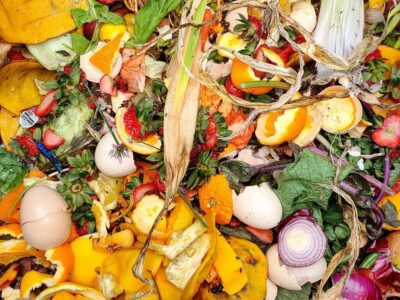
By Aurora Barone and Tamar Aharoni
We’ve all been there before. We rummage around our fridge to find those long-forgotten strawberries we bought days ago. Our intentions were good. We really did intend to eat them, but now they’ve been colonized by an unappetizing mold. Alas, the time has come to bid farewell to the snack that should have been but never was. With a final glance, we toss them in the trash for good.
But when we throw away our strawberries, are we just throwing away the strawberry? Absolutely not. We’re throwing away all the water used to grow each strawberry. We’re wasting all the energy and fuel used to transport and store them. We’re creating more solid waste for our near-capacity landfills, where they will emit harmful greenhouse gases as they slowly decompose.
When we think about environmental problems, images of industrial pollution or car exhaust come to mind — not dinner. In reality, the food sector poses one of the largest threats to our planet.
Food waste occurs at all stages of the food cycle: when farmers leave unharvested crops to rot in fields because it is not profitable to harvest them; when inappropriate storage and handling causes food to spoil; when retailers turn away ‘ugly’ produce; and when confusing date labels cause consumers to discard food that is still safe to eat. Food waste at each of these stages contributes to 40 percent of all food produced in the U.S. going uneaten — a fact made paradoxical given that one in six people in the U.S. faces food insecurity.
Agriculture accounts for up to 80 percent of freshwater consumption in the U.S. To produce 8 ounces of strawberries, it takes about 10 gallons of water, whereas six ounces of steak requires an exorbitant 674 gallons of water!
Given that agriculture takes up 50 percent of land area in the U.S., proper water management matters greatly as droughts will continue to exacerbate water scarcity. California, often referred to as America’s breadbasket, is already vulnerable to drought, and as climate change intensifies, these droughts will only last longer and happen more frequently.
When we waste food, we are also wasting the fuel required to transport it. Transporting food from farms to consumer households consumes 10 percent of the total U.S. energy budget.
The impact of food waste ripples into other issues, too, including municipal solid waste and greenhouse gas emissions. Uneaten food comprises the largest category of municipal solid waste reaching U.S. landfills, and it accounts for 23 percent of U.S. methane emissions, since methane is a byproduct of its decomposition.
Of all these losses and negative impacts, we feel it most on our wallets. For the average family of four, food waste translates to an estimated $1,350 to $2,275 lost per year.
The Problem With Food Labels
Confusing date labels cause a large portion of food waste. In the absence of federal standards, food manufacturers and retailers decide on labels and cut-off dates based on their own market standards. Consequently, American consumers find diverse and inconsistent food date labels in grocery stores. Various items read ‘sell by’, ‘use by’, ‘best by’, and/or ‘enjoy by’, and their meanings vary from product to product.
These labels make it difficult to differentiate between safety and quality, causing consumers to discard food prematurely. Consumers may believe a food item is no longer safe to eat when really the label merely indicates that it tastes better before the listed date. Some reports have found that label confusion accounts for up to 20 percent of food waste.
In 2017, the Consumer Goods Forum Board of Directors unanimously adopted a call to action to simplify date labels. To reduce food waste by 2020, the call to action suggests retailers and food producers display only one label at a time, choose between a safety date for perishables and a quality date for non-perishables, and educate consumers on date label meaning. Companies like Tesco, Kellogg, Walmart, Campbell Soup, Nestlé, Carrefour, and Unilever have agreed to these harmonized date label guidelines, but no consequences, other than bad optics, exist if these companies do not comply.
In 2008, in-store food losses at the retail level totaled an estimated 10 percent of the total food supply, amounting to 43 billion pounds. However, an accurate estimate is hard to come by; very few companies attempt transparency in reporting their food losses. (Nestlé and Tesco are a few exceptions.) Large food production companies have no obligation to report their waste inventories, so retailers still continue to waste perfectly safe food for a variety of reasons, such as not meeting cosmetic standards.
What You Can Do
Food waste represents a systemic issue that requires strong federal action. With that said, there is still a lot that individuals can do to mitigate consumer food waste.
- Imperfect Produce and Misfits Market work to find a home for ‘ugly’ produce. Sourced directly from farmers and delivered directly to your door, ugly fruits and veggies are sold for up to 50 percent less than their prettier grocery store counterparts. Imperfect Produce serves most major U.S. cities and will be coming to New York soon. Misfits Market currently operates in New York.
- GrowNYC offers food scrap collection at dozens of sites throughout New York. Composting may seem like a pipe dream for urban dwellers, but you can divert your own food waste from landfills by visiting one of these sites.
- Know your date labels. For many products, a ‘use by’ label indicates that it is no longer safe to eat after the specified date. A ‘best by’ or ‘best before’ label merely means that its overall quality will be best before the date listed; the food item is still safe to eat. Check out the USDA’s guide to food date labels.
- Recipes for food past its prime. Are those tomatoes too ripe for a salad? Do the peels on your uneaten bananas resemble the same color as asphalt? Check out these creative recipes that can help you make the most of food past its prime.
Aurora Barone and Tamar Aharoni graduated in May 2019 with a Master of Public Administration in Environmental Science and Policy. They work with the Earth Institute on environmental policy issues.



